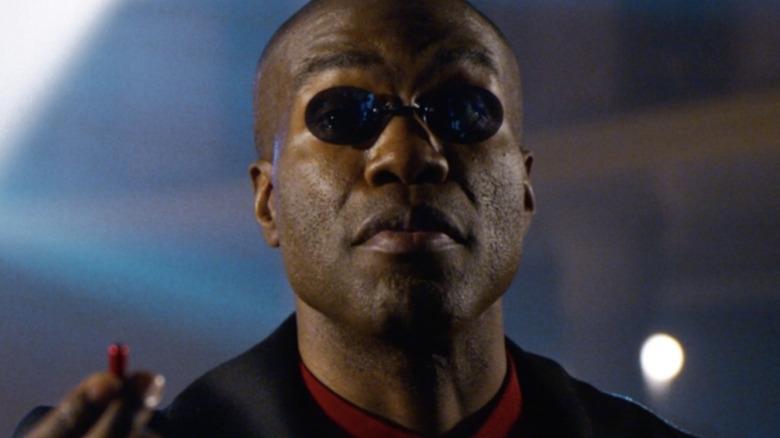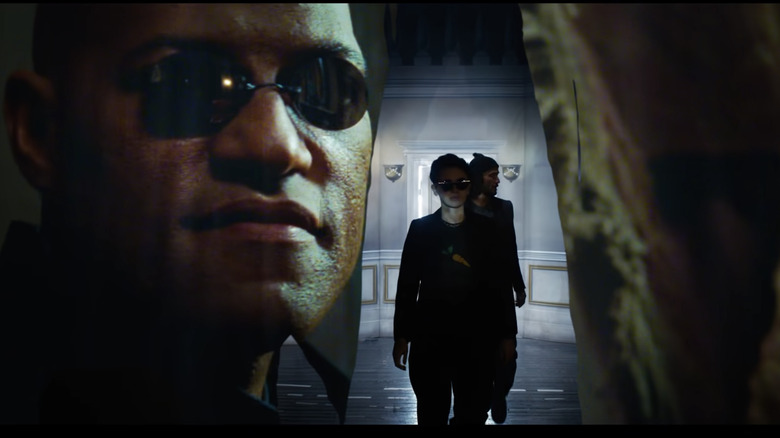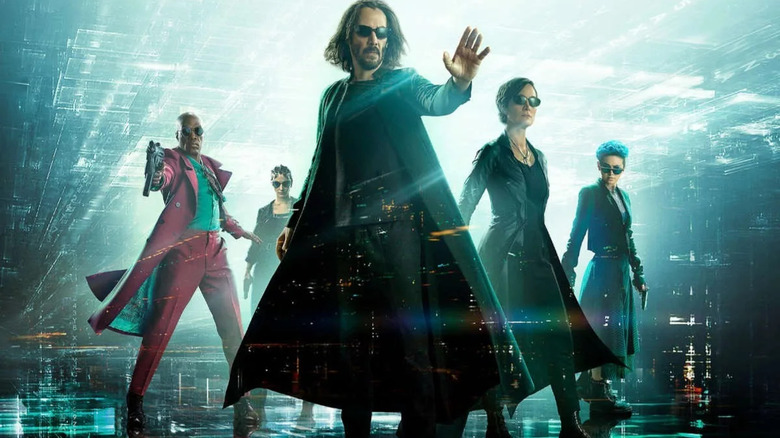The Matrix Resurrections Review: A Hard Pill To Swallow
It's interesting how the "Matrix" movies have become so reliant on tired Lewis Carroll cliches, because the franchise feels like it has become trapped in its own "Alice in Wonderland" fever dream. Now comes "The Matrix Resurrections," a new installment that exists solely because we're still chasing the feels the original masterpiece gave us — and once again, at the bottom of this rabbit hole is nothing revolutionary.
When the original film hit theaters in 1999, it came out of nowhere. Released well outside the summer season, with little advance hype and starring an actor who hadn't had a hit in over a half-decade, nobody was expecting much. But when you consider the look (the sunglasses, the trenchcoats), the coined terms and phrases (blue pill vs. red pill, there is no spoon), the cinematic revolution of "bullet time," the forward-thinking statements on tech and race and sexual identity, and the overall call to action, the film felt like to so many, coupled with those iconic performances, it's no wonder we're all still chasing that feeling we had the first time we saw it.
It's also no wonder that writer/director Lana Wachowski (along with writers David Mitchell and Aleksanar Hemon) spend so much time in "Resurrections" either making reference to the first film, trying to mimic the story beats from the first film, or making tongue-in-cheek jokes addressing the elephant in the room: the first film was not made with a fourth film in mind, and there's no reason for this to exist. So instead, they give us a character named "Bugs" who has a rabbit tattoo, wears a t-shirt with a carrot on it and at one point asks "What's up, doc?"
Sure enough, Thomas Anderson chases this bunny down the rabbit hole (to the strains of Jefferson Airplane's "White Rabbit," no less), once again giving us hope that a "Matrix" sequel will bring us clear, intelligent, unexpected world-building rather than mumbo-jumbo and empty calories. Well, at least you can say this about "Resurrections" — it's a lot better than "Reloaded" and "Revolutions," if only because those films were trying to move beyond the original "Matrix," not simply repeat it.
Ghosts of Matrix past
"Resurrections" is set some 20 years after we last saw Thomas Anderson/Neo. He has settled back into the office worker tedium we all recall, but at least now he is a boss, and a somewhat respected one at that, having created a series of successful "Matrix" video games. We're led to believe that these games were a big hit, but that Anderson struggled with some form of depression and nearly killed himself by stepping off the roof of a building; now, he spends his days popping blue pills prescribed to him by his therapist (Neil Patrick Harris) and being brought out of his trance-like daydreams by a cat named Deja Vu.
Wachowski lays the "Matrix" flashbacks on thick, sometimes in Terrence Malick-like soundless images playing over lines of dialogue that parallel the earlier moment in text or theme, other times in actual scenes projected around the "Resurrections" actors as if they're an '80s pop act in a music video promoting a feature film. At times, it sheds some light on a moment; more often, it just makes you want to go watch the original.
Thomas Anderson has a boss he does not care for (Jonathan Groff), a job he does not like, and the nagging sensation that the woman he keeps seeing at the coffee shop has something to do with his destiny. That woman, of course is ... Tiffany. But we all know she's actually Trinity (Carrie-Anne Moss), similarly under the mind control of the Matrix and believing she's a soccer mom with kids, a husband and an expensive latte habit.
From here, it's like catching a cover band at your local bar who plays all those songs you remember so fondly. Morpheus (albeit a different version, played by Yahya Abdul-Mateen II) sends Neo cryptic but helpful messages, extracting him from his false reality as agents swoop in to use deadly force. Pills are offered, explained, and accepted. The eyes of Neo are opened, and ours alongside him, as we see the hellacious reality of what the world has become.
Similarly recounting previously trod-upon ground, Neo meets a small group of rebels looking to fight back. But this time, several of them explain that they are relatives of the original "Matrix" cast and/or have some connection to previous storylines. As we later discover, what Neo thinks has been 20 years of time passage is actually 60 years, most vividly portrayed by the character of Niobe, who once looked like Jada Pinkett Smith and now looks like ... Jada Pinkett Smith starring in a "Benjamin Button" remake.
This is where the plot kicks in, which essentially revolves around freeing the mind of Trinity and taking down Neil Patrick Harris, who is the Architect ... er, the Analyst. Along the way are a half-dozen or so decent fight scenes, enough callbacks and Easter eggs to make Kevin Feige say "whoa, slow down," and plenty of dim characters spitting out things like "reboots sell!" and "we need a new bullet-time!" Give Wachowski credit for acknowledging the film's biggest obstacle — but expressing annoyance at not having a raison d'etre doesn't give a film a raison d'etre.
What's up, new Morpheus?
Perhaps all this is too harsh. If you want to see Keanu Reeves play Neo again and dress in all black and do the kung fu scene, good news: he does. If you want to see Carrie-Anne Moss also dress in black and demonstrate once again that chemistry between two actors is simply an unquantifiable superpower that cannot be denied, she does that admirably. If you want to see motorcycle chases, slow-motion bullet rounds flying at the camera and many, many kicks to the face, settle in. If you want to see Christina Ricci and Priyanka Chopra Jonas ... well, don't blink, because they're barely in it.
Whether we're living in the real world or a manufactured reality, we should all give high-fives to Harris, Groff and Mateen, who are across the board excellent, intense, and memorable. Are Laurence Fishburne, Hugo Weaving —and yes, Joe Pantoliano, a huge part of that original film — sorely missed? Absolutely. Would it have been a mistake to bring those actors back to simply make this a "reunion" film without anything breathing fresh life into it? For sure. The performances throughout the film are terrific, even if many are just pacing back and forth on well-worn, outdated carpet.
There is exactly one idea in "The Matrix Resurrections" that feels new, fresh and exciting. Something that, for a moment, recaptures the thrill of seeing that first film when it came out. Near the end of "Resurrections," Neo and Trinity speed through (what sure does look a lot like) San Francisco, as the Analyst turns all of reality against them. In many citizens, this manifests itself as a zombie-like state, not terribly original. But then, one guy is depicted as waking up alongside his girl and then immediately hurling himself out the window, dozens of levels above the ground. Quickly, you realize: All these downtown buildings have countless people smashing through the windows above, falling to their deaths like sacks of wet cement in desperate, mindless, death-spiral attempts to hit our heroes' Ducati.
The image is amazing, the concept is very clever, and the whole scene is simultaneously haunting, thrilling, and metaphorical on whatever level you'd like it to be. And that, right here, is what "The Matrix" was at its best. For a moment, we get just a taste, straight out of 1999 — and that's probably enough to get a dozen more of these movies made, as we all just keep on chasing the feels.


